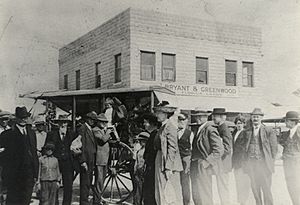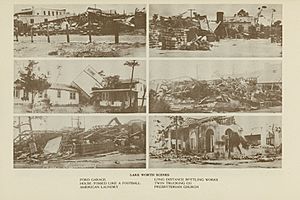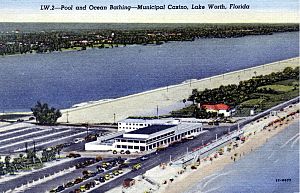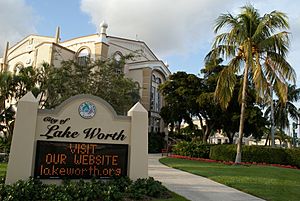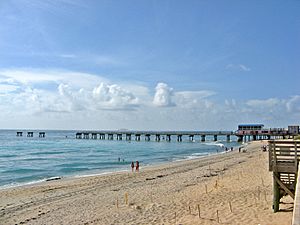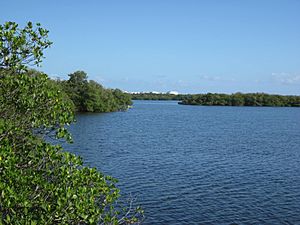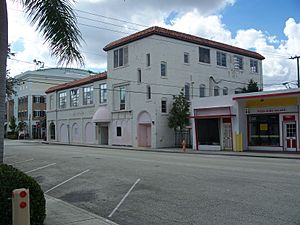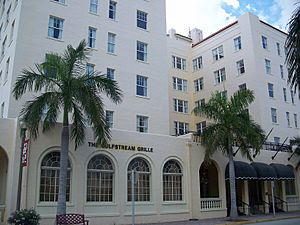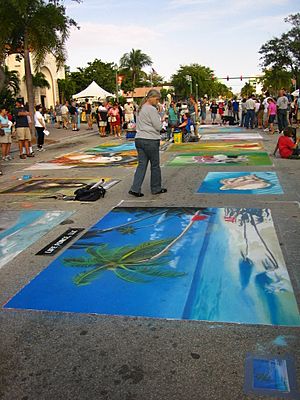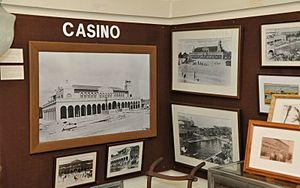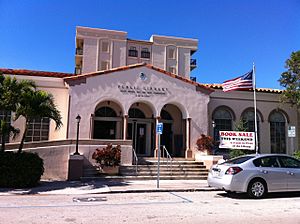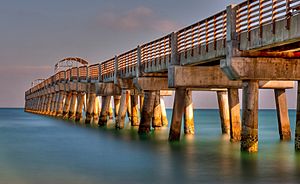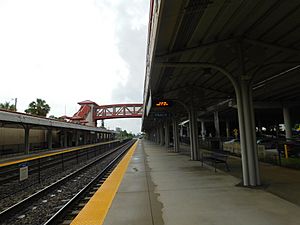Lake Worth Beach, Florida facts for kids
Quick facts for kids
Lake Worth Beach, Florida
|
|
|---|---|
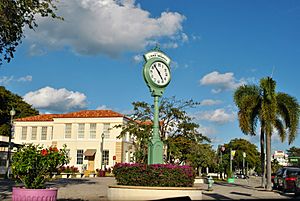
Downtown Jewel, Lake Worth Beach
|
|
| Motto(s):
"The Art of Florida Living"
"Where The Tropics Begin" |
|

Location of Lake Worth Beach, in Palm Beach County, Florida
|
|
| Country | |
| State | |
| County | |
| Settled (Jewel Settlement) |
c. 1885 |
| Platted (Lucerne) | 1911 |
| Incorporated (Town of Lake Worth) |
June 14, 1913 |
| Incorporated (City of Lake Worth) |
1925 |
| Incorporated (City of Lake Worth Beach) | March 12, 2019 |
| Named for | Lake Worth Lagoon and William J. Worth |
| Government | |
| • Type | Commission-Manager |
| Area | |
| • City | 17.65 km2 (6.81 sq mi) |
| • Land | 15.26 km2 (5.89 sq mi) |
| • Water | 2.38 km2 (0.92 sq mi) 13.51% |
| Elevation | 5 m (16 ft) |
| Population
(2020)
|
|
| • City | 42,219 |
| • Density | 2,766.10/km2 (7,164.26/sq mi) |
| • Metro | 6,138,333 |
| Time zone | UTC−5 (EST) |
| • Summer (DST) | UTC−4 (EDT) |
| ZIP codes |
33460, 33461, 33463, 33467
|
| Area code | 561, 728 |
| FIPS code | 12-39075 |
| GNIS feature ID | 0285292 |
Lake Worth Beach is a city in Palm Beach County, Florida, United States. It's located about 63 miles (101 km) north of Miami. The city gets its name from the Lake Worth Lagoon, a body of water on its eastern side. This lagoon was named after General William J. Worth, a leader in the Second Seminole War.
Lake Worth Beach is south of West Palm Beach and north of Lantana. In 2020, about 42,219 people lived here. The city is part of the larger Miami metropolitan area, which had over 6 million people in 2020.
The first known settlers in the area were Samuel and Fannie James, an African American couple, who arrived in 1885. Fannie James even ran the local post office, called Jewell, for many years. In the 1910s, a plan to sell land helped the population grow quickly. The town was officially named Lake Worth in June 1913. It grew a lot during the 1920s and after World War II. In 2019, residents voted to change the city's name to Lake Worth Beach.
Today, Lake Worth Beach is known for its historic neighborhoods like College Park and Old Lucerne. Its downtown area also has many historic buildings. The city is very diverse, with people from many different backgrounds. It hosts fun events each year, including a street painting festival and one of Florida's largest LGBTQIA+ pride festivals.
Contents
History of Lake Worth Beach
Early Days and First Settlers
Native Americans lived in Florida thousands of years ago. The Jaega tribe was known to live along the Atlantic coast in areas like Martin and Palm Beach counties. Evidence of their presence, like shell mounds, dates back to about 750–1500 CE near Lake Worth Beach.
Samuel and Fannie James were among the first non-Native American settlers. They were an African American couple who settled near the Lake Worth Lagoon in 1885. They claimed 187 acres (76 ha) of land under the Homestead Act. Fannie James also ran the Jewell Post Office from 1889 to 1903. This post office served the few families living between Lantana and West Palm Beach.
The James family sold much of their land to new residents and investors starting in the 1890s. After Samuel passed away in 1909, Fannie sold her remaining 156 acres (63 ha) to a developer. She kept a small farmette outside the new city limits.
In the 1890s, after the Florida East Coast Railway (FEC) was extended, a plan was made to build a town. People who bought farmland in what is now Greenacres would also get a small lot in the new town. The developers, Bryant & Greenwood, advertised the area across the United States and Canada. They wanted to name the town Lucerne, but the United States Postal Service said no because another place already had that name. So, the founders chose Lake Worth instead.
In 1911, the area was mostly wild woods. By July 1912, the population was only 38 people. But things changed quickly. That year, a library, school, newspaper, and the first church were all started. The first train station, run by the FEC, also opened. By December 1912, the town had 308 residents, 125 houses, and even seven automobiles!
Becoming a City and Growth
Lake Worth Beach officially became the "town of Lake Worth" on June 14, 1913. Its first elected mayor was James Love, a carpenter. The town grew so fast that a new area was added for development in its first year. This area, along the Intracoastal Waterway, is still called Addition 1.
In 1919, a wooden bridge was built over Lake Worth for cars. The town also received a piece of land on the barrier island, which became the municipal beach.
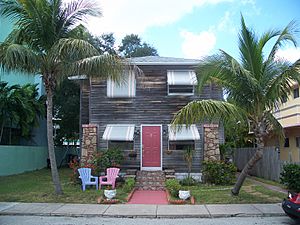
Lake Worth grew very quickly during the Florida land boom of the 1920s. The population jumped from 1,106 in 1920 to almost 6,000 by 1930. In 1920, the city approved a $100,000 bond to build the Mediterranean Revival-style Lake Worth Casino and Baths. When it opened two years later, it attracted many tourists.
The 1920s also saw the building of the Gulf Stream Hotel, which is now a historic landmark. Lake Worth Community High School was built in 1922. Many other commercial buildings and neighborhoods, like College Park, were also developed. Lake Worth became a city in 1925, and its borders expanded several times.
William A. Boutwell, who arrived in the 1920s, started Boutwell Dairy in 1927. He is known for inventing "half & half creamer." He also served as a city commissioner and briefly as vice mayor. During his time, the city built many roads and two elementary schools.
The 1928 Okeechobee hurricane caused huge damage to Lake Worth. About 600 homes were destroyed, and 1,500 more were damaged, leaving 700 people without homes. Most businesses in the downtown area were also wrecked or badly damaged. The bridge across the Intracoastal Waterway was almost completely destroyed. The hurricane caused about $4 million in damage and three deaths in Lake Worth.
After the storm, the Gulf Stream Hotel became a temporary hospital. The city government had to move to a temporary building. The hurricane, along with the Great Depression, caused a tough economic time for the community. Most construction focused on repairs. However, some new projects were built in the 1930s, including the current Lake Worth Beach City Hall, which was built by the Works Progress Administration.
From World War II to Today
During World War II, Lake Worth's population grew because of nearby military bases. After the war, many veterans moved back to the area, leading to a population boom. Many immigrants, especially from Finland, also moved to Lake Worth, bringing their culture and helping the local economy.
Two hurricanes hit Lake Worth in the late 1940s. The 1947 Fort Lauderdale hurricane damaged many businesses and homes, including the Lake Worth Casino. The casino was repaired and reopened in the 1950s with a new look. The 1949 Florida hurricane also caused damage, especially to homes in the Osborne Colored Addition.
In 1954, a concrete wall was built in the Osborne Colored Addition to separate it from a white neighborhood. Even though the city officially ended segregation in 1969, the neighborhood kept its name until 1994. Today, parts of the wall remain and are covered with murals, known as the Unity Wall. Schools in Palm Beach County were slow to integrate. John Green and Theresa Jakes Kanu were among the first Black students to attend Lake Worth High Community High School in 1961.
The 1960s and 1970s saw many new apartments and commercial buildings built, often replacing older ones. The current bridge across the Intracoastal Waterway opened in 1973. Also in 1973, the Lake Worth City Hall moved to its current location. The old City Hall building is now a historic landmark and home to the Lake Worth Historical Museum.
Since the 1980s, many immigrants from Central America and the Caribbean have moved to Lake Worth Beach. This includes many Guatemalan-Mayans who speak languages like Mam or Q'anjob'al. There is also a large Haitian population, many of whom speak Creole. This has made Lake Worth Beach a very diverse city.
Downtown Lake Worth Beach was restored in the late 1990s, making it a popular spot with art galleries, cafes, and nightclubs. The city's main street, Lake Avenue, has some of the oldest commercial buildings in South Florida. This area is part of the Historic Old Town Commercial District, which became a historic landmark in 2001.
In the 2000s, hurricanes Frances, Jeanne (2004), and Wilma (2005) caused significant damage. Wilma alone destroyed 27 homes and 7 businesses. The William O. Lockhart Municipal Pier was also badly damaged by these storms and needed $3.4 million for repairs.
In 2019, residents voted to change the city's name to Lake Worth Beach. One reason was to help people tell the difference between the city and its nearby suburbs. Another reason was to attract more tourists by highlighting its beach town identity.
Geography and Climate
Lake Worth Beach covers about 6.81 square miles (17.6 km2). Most of this is land, with 0.92 square miles (2.38 km2) being water.
The city is named after the Lake Worth Lagoon. This lagoon connects to the Atlantic Ocean through the Lake Worth Inlet. The lagoon is a long channel that runs through much of Palm Beach County. It's now an estuary (a mix of fresh and saltwater) because of the man-made inlets.
Lake Worth Beach has a tropical climate, much like the Caribbean. This means it's warm all year round with a wet season and a dry season.
City Neighborhoods
The Lake Worth Beach Community Redevelopment Agency (CRA) works with neighborhood groups to improve the city. They help different neighborhoods communicate with the city government and encourage volunteering.
Lake Worth Beach has 17 recognized neighborhood associations, including:
- Bryant Park
- College Park
- Downtown Jewel (Downtown Lake Worth Beach)
- Eden Place
- Lake Cove
- Mango Groves
- Memorial Park
- Murray Hills
- Parrot Cove (Old Lucerne)
- Pineapple Beach
- ROLO (Residences on Lake Osborne)
- Royal Poinciana
- South Palm Park
- Sunset Ridge
- Tropical Ridge
- Vernon Heights
- Whispering Palms
College Park and Old Lucerne are special because they are historic districts listed on the National Register of Historic Places (NRHP). Most homes in College Park were built between 1925 and 1949. The Old Lucerne district is where Samuel and Fannie James lived. It has many historic buildings built from about 1913 to 1951.
Downtown Lake Worth Beach
The Historic Old Town Commercial District is a large part of downtown Lake Worth Beach. It was added to the NRHP in 2001. This area has 59 buildings, with 46 of them being historic. These buildings were built between 1912 and 1949. They show different styles of architecture, like Art Deco and Mediterranean Revival.
Downtown Lake Worth Beach is a lively place for both locals and visitors. Many important city buildings are here, including the current City Hall, the Old Lake Worth City Hall (which also houses the Lake Worth Historical Museum), the Lake Worth Beach Post Office, and the Lake Worth Playhouse.
Population and People
| Historical population | |||
|---|---|---|---|
| Census | Pop. | %± | |
| 1920 | 1,106 | — | |
| 1930 | 5,940 | 437.1% | |
| 1940 | 7,408 | 24.7% | |
| 1950 | 11,777 | 59.0% | |
| 1960 | 20,758 | 76.3% | |
| 1970 | 23,714 | 14.2% | |
| 1980 | 27,048 | 14.1% | |
| 1990 | 28,564 | 5.6% | |
| 2000 | 35,133 | 23.0% | |
| 2010 | 34,910 | −0.6% | |
| 2020 | 42,219 | 20.9% | |
| U.S. Decennial Census | |||
Lake Worth Beach is the ninth largest city in Palm Beach County. In 2020, it had 42,219 residents. It is one of the most diverse cities in the county, with many different ethnic and racial groups.
Many residents were born outside the United States, especially from the Caribbean and Latin America. In 2021, about 38.7% of residents were born in other countries. Also, only about 44.9% of people in Lake Worth Beach spoke only English.
The median household income in Lake Worth Beach in 2019 was $42,500. This was lower than the average for Palm Beach County and Florida. About 24.4% of residents were considered to be living in poverty in 2019.
Economy and Jobs
In 2019, Lake Worth Beach had about 19,978 people in its workforce. The largest employers in the city include Palm Beach State College, the city government, and Lake Worth Community High School. Other major employers are American Medical Assistance, Highland Elementary School, and Publix.
Most jobs in Lake Worth Beach are in areas like professional services, construction, education, healthcare, and hospitality.
The Lake Worth Beach Community Redevelopment Agency (CRA) works to improve properties and encourage economic growth. Since 2001, the CRA has focused on areas like Dixie Highway and parts of 6th Avenue South and 10th Avenue North. The downtown area has seen a big comeback, with many art galleries, cafes, and nightclubs.
The Gulf Stream Hotel, which has been closed since 2005, is planned for renovation. Voters strongly approved this plan in 2020. The city commission also approved a proposal to renovate the hotel and build a new one nearby.
LGBT Sanctuary City
In September 2023, the city council officially declared Lake Worth Beach an "LGBT sanctuary city." This means the city aims to protect and support LGBT rights for its residents.
Culture and Arts
Arts and Creativity
The Cultural Council for Palm Beach County supports and promotes arts and culture in the area. In 2012, it moved its headquarters to Lake Worth Beach. This building used to be the Lake Theatre, which opened in 1940. The Cultural Council hosts many events at its building and around Palm Beach County.
Downtown Lake Worth Beach has many art galleries, such as Art Link International and Artisans on the Ave. Other art places include the Armory Arts Center and the Lake Worth Playhouse. The Lake Worth Playhouse started in 1953. It is in a building that was once the Oakley Theatre, which was damaged by a hurricane in 1928. Today, the Playhouse hosts ballets, dramas, movies, musicals, and operas all year.
Festivals and Events
Lake Worth Beach hosts several annual festivals:
- Lake Worth Beach Street Painting Festival: This event brings about 100,000 people to downtown. Over 600 artists create amazing artworks right on the asphalt streets.
- FOCUS Lake Worth: In November, this festival features different types of art displays and murals downtown.
- Midnight Sun Festival: Originally called Finlandia Days, this event celebrates Lake Worth Beach's Finnish population. It has been held annually at Bryant Park since 1983.
- Oktoberfest: One of the largest Oktoberfest events in South Florida is held just outside the city.
- Día de los Muertos: A Day of the Dead event is held in the downtown area in late October.
The annual Palm Beach Pride parade is also held in Lake Worth Beach. It's one of the largest and oldest pride parades in Florida, attracting over 30,000 people. Lake Worth Beach also has Compass, the county's only LGBT community center.
The city also organizes a "Lake Worth Festival of Trees" and a monthly "Lake Ave Block Party." During the cooler months, bonfires are held at the Lake Worth Beach Casino and Beach Complex.
Movies Filmed Here
A big part of the 1981 movie Body Heat, starring William Hurt and Kathleen Turner, was filmed in downtown Lake Worth Beach. The city was called Miranda Beach in the movie. The 1984 movie Harry & Son was also filmed in Lake Worth Beach.
Preserving History
The Lake Worth Historical Museum is on the second floor of the old Lake Worth City Hall. This building was the city's main office from the 1920s to 1973. The Historical Society of Lake Worth is located at the public library.
The city has worked hard to preserve its historic buildings and areas since 1996. In 2017, seven homes built in 1912 were named historic properties, as they are the oldest homes in the city without major changes. Many small cottages were built between 1913 and 1949. About 1,000 of these cottages still exist, making it the largest collection of this type of home in Florida.
Lake Worth Beach has six areas considered historic districts: College Park, Northeast Lucerne, Old Lucerne, Old Town, Southeast Lucerne, and South Palm Park. The federal lists three historic districts and three historic buildings in Lake Worth Beach: College Park, Old Lucerne, Old Town, the Gulf Stream Hotel, Old Lake Worth City Hall, and Osborne School.
Education
Public Schools
Public schools in Lake Worth Beach are part of the School District of Palm Beach County.
- Elementary Schools: Barton, Highland, North Grade, and South Grade Elementary Schools are all within the city.
- Middle Schools: Students north of 12th Avenue South attend Lake Worth Middle School. Those south of 12th Avenue South go to Lantana Community Middle School in Lantana.
- High School: All public high school students in the city attend Lake Worth Community High School. It opened in 1922 and is the oldest high school in Palm Beach County that is still open.
Sacred Heart Catholic Church runs a private school (pre-K–8) in Lake Worth Beach. There is also a charter school called the Academy for Positive Learning.
The former Osborne School, built in 1948, served Black elementary students in the segregated Osborne neighborhood until 1971. It is now listed on the NRHP and in Florida's Historic Black Public Schools Multiple Property Submission.
The main campus of Palm Beach State College is located near Lake Worth Beach. It is Florida's oldest community college, founded in 1933.
Public Libraries
The Lake Worth Beach Public Library is in the historic downtown area. It's a beautiful Mediterranean-style building completed in 1941. The library lends out about 65,000 items each year, mostly books.
People in Lake Worth started trying to create a library in 1912, even before the city was officially formed. For many years, the library was inside City Hall. In 1926, residents voted to build a library, but they didn't have enough money. In 1939, a bill to fund a library was vetoed by the President. However, residents kept raising money, and the building was finally finished in 1941.
The library also has a special children's section and unique art collections. Besides the main library, Lake Worth Beach has over 100 Little Free Library book exchanges. These small book-sharing boxes were started by a resident named Mary Lindsey and many volunteers. By late 2020, these Little Free Libraries had given out about 500,000 books!
Fun and Recreation
Lake Worth Beach has a great municipal beach, which is one of the few large public beach areas left in Southeast Florida. In 2013, the Lake Worth Casino complex reopened after a $6 million renovation. This building looks like the original 1920s casino.
Near the casino is the William O. Lockhart Municipal Pier, a famous landmark. After Hurricane Frances in 2004, the pier was repaired and raised 5 feet (1.5 m). The pier's structure helps create sandbars, which means it often has good waves for surfing.
The Snook Islands Natural Area is a 118-acre (48 ha) wetland area with a boardwalk and kayak launch. The city also has an 18-hole municipal golf course with great views. Bryant Park, in downtown Lake Worth Beach, has a 1930s bandshell designed by Addison Mizner, used for festivals and events. Overall, Lake Worth Beach has more than 20 parks and recreational spots. On the west side of the city, John Prince Memorial Park offers miles of bike and walking trails and places for picnics and camping.
Media and News
The Lake Worth Herald and Coastal/Greenacres Observer is a weekly newspaper based in the city. It covers news for Lake Worth Beach and nearby towns. The Lake Worth Herald started in 1912 and is considered the city's oldest business.
The Palm Beach Post is a daily newspaper that serves Lake Worth Beach and the wider Palm Beach County area.
Lake Worth Beach is part of the West Palm Beach–Fort Pierce television market. This means you can watch major TV networks like NBC, CBS, ABC, and FOX. Many radio stations also broadcast in the city, including WWRF, a Spanish-language station based in Lake Worth Beach.
City Services
Transportation
Interstate 95 runs through the west side of Lake Worth Beach, with two exits in the city. Several other major roads, like U.S. Route 1 (Dixie Highway) and North Federal Highway, run north-to-south. State Road 802 (Lake Worth Road) runs east-to-west. The Robert A. Harris Bridge, built in 1973, connects Lake Worth Beach to its municipal beach across the Intracoastal Waterway.
The nearest commercial airport is Palm Beach International Airport in West Palm Beach. There's also a smaller public airport, Palm Beach County Park Airport, just southwest of the city.
The Tri-Rail commuter train system serves Lake Worth Beach at the Lake Worth Beach station, which opened in 1989. Tri-Rail connects the city to other places in Palm Beach, Broward, and Miami-Dade counties. The city is also served by PalmTran buses, which have routes throughout the area.
Emergency Services
Lake Worth Beach used to have its own fire department. In 2009, it merged with Palm Beach County Fire Rescue (PBCFR) to save costs and offer better opportunities for firefighters. PBCFR has two stations in the city.
Lake Worth Beach has an Emergency Management Program to help prepare for and recover from emergencies like hurricanes. Parts of the city are in Evacuation Zone C, meaning residents might need to evacuate if a strong hurricane (Category 3 or higher) threatens the area. The closest hospital is JFK Medical Center in Atlantis.
Utilities
Unlike many other cities in Florida, Lake Worth Beach runs its own electrical utility. It started in 1914 and now serves about 27,000 customers, including some nearby areas. To help the environment, the city bought and started operating a solar farm in 2017. This made it the first city in Florida to do so. By 2021, over 38% of the city's electricity came from solar energy.
The Lake Worth Beach Water Utilities Department provides drinking water and manages wastewater and stormwater. Drinking water comes from a treatment plant and is sent through 168 miles (270 km) of pipes. The city also collects wastewater from nearby towns and sends it for treatment. Stormwater drains into the Lake Worth Lagoon.
Notable People
Many interesting people have connections to Lake Worth Beach, including:
- Arthur Altman, a songwriter.
- Trey Amburgey, a former MLB baseball player.
- Martin Amis, an author.
- Toni Arden, a singer.
- Joe Arnold, a baseball coach.
- LaVon Brazill, a former NFL wide receiver.
- Mark Brownson, a former MLB pitcher.
- Daniel Cane, co-founder of Blackboard Inc. and CEO of Modernizing Medicine.
- Matt Cetlinski, an Olympic gold medalist swimmer.
- James Currie, a birdwatching expert.
- Mary Dees, an actress.
- Kevin Fagan, a former NFL defensive end and two-time Super Bowl champion.
- Guy Fieri, a celebrity chef.
- Mark Foley, a former U.S. House of Representatives member.
- Jonathan Garvin, a UFL linebacker.
- Ghostemane, a hip-hop artist.
- Andrea Hall and Deidre Hall, identical twin actresses.
- Andy Hansen, a former MLB pitcher.
- Omari Hardy, a politician.
- Scott Henderson, a jazz fusion guitarist.
- Philip L. B. Iglehart, a polo player.
- Teresa James, an aviator and one of the first Women Airforce Service Pilots.
- Ken Jenne, a former Florida State Senator and sheriff.
- Dave Kerner, director of the Florida Department of Highway Safety.
- Brooks Koepka, a professional golfer and multiple major champion.
- Scott "Raven" Levy, a professional wrestler.
- James Looney and Joe Looney, former NFL players.
- K.C. McDermott and Shane McDermott, former NFL players.
- Bill Meredith, a musician and journalist.
- Vahid Mirzadeh, a tennis player.
- Jacob Montes, a soccer player.
- Cindy Morgan, an actress.
- Robin Morgan, a poet, writer, and activist.
- Pat O'Donnell, an NFL punter.
- Joe Pags, a talk radio and television host.
- Alexa Pano, a professional golfer.
- James Patterson, a famous author.
- A. T. Perry, an NFL wide receiver.
- Theodore Pratt, a journalist and novelist.
- John and Greg Rice, known as the "World's Shortest Living Twins."
- Betty Robbins, one of the first female Jewish cantors.
- Herb Score, a former MLB player.
- Snot, a rapper and singer-songwriter.
- Susan Stanton, a former city manager.
- Otis Thorpe, a former NBA player.
- Trea Turner, an active MLB player and World Series champion.
- Viola Turpeinen, an acclaimed accordion player.
- Edward Wallowitch, an art photographer.
- Carroll Widdoes, a former college football coach.
Sister Cities
Lake Worth Beach has sister city relationships with:
- Lappeenranta (
 Finland)
Finland) - Saint-Marc (
 Haiti)
Haiti) - Southend-on-Sea (
 England)
England) - Sopot (
 Poland)
Poland)
See also
 In Spanish: Lake Worth (Florida) para niños
In Spanish: Lake Worth (Florida) para niños


